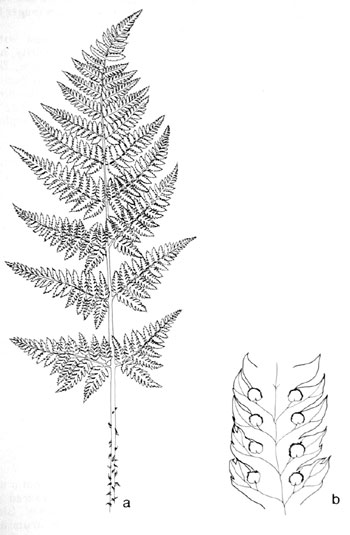| Dryopteris carthusiana | ||
Spinulose wood fern | ||
|
Etymology
Carthusiana is named after the botanist Johan Friedrich Cartheuser (1704-1777). An alternative origin is the village of Carthusium in Dauphin�, France, where Dominique Villars collected it.
Description
Rhizome: short-creeping, forming an asymmetric clump, covered with old stipe bases.
Frond: 60 cm high by 15 cm wide, deciduous, monomorphic, though the sterile fronds tend to be somewhat shorter, arching, blade/stipe ratio: 2:1 to 3:1. Stipe: grooved, base enlarged (trophopod), light brown scales at base, less above, vascular bundles: 5 in a c-shaped pattern. Blade: 2-pinnate-pinnatifid, ovate-lanceolate, herbaceous, glabrous above, glabrous or with a few scales or glands below. Pinnae: 12 to 14 pair, held almost horizontally, the lowest one weakly anadromic, not reduced or only slightly reduced in length compared to the second pair; pinnules first lower pinnule of basal pinna twice as long as upper one, and also larger than second lower pinnule; costae grooved above, continuous from rachis to costae; margins margins serrate, teeth spiny; veins free, forked. Sori: round, in 1 row between midrib and margin, at the tips of veins, usually absent on the lowest pinna, indusium: reniform, gray-white, at a sinus, sporangia: dark brown, maturity: midsummer. Dimensionality: nearly horizontal pinnae, tips pointing upward. Culture
Habitat: wet woods, moist wooded slopes, stream banks, swamps.
Distribution: circumboreal, south to Pyrenees, Himalayas.
Hardy to -40�C, USDA Zone 2.
Distinctive Characteristics
lowest pinna: relative size of pinnules (as above) and first lower pinnule nearly opposite first upper pinnule; in the similar D. dilatata and D. expansa the first upper pinnule is distinctly closer to the rachis (anadromic).
Synonyms
Dryopteris spinulosa (O. F. Mueller) Watt. Polypodium carthusianum Villars Dryopteris austriaca (Jacquin) Schinz & Thellung var. spinulosa (O. F. Mueller) Fiori Polypodium spinulosum O. F. Mueller Polystichum spinulosum Lam. & DC. Thelypteris spinulosa Nieuwl. |
|
|
Notes
Compare to Differs from D. intermedia in that the first set of pinnules on the basal pinnae are longer than the second set.
Compare to Differs from D. intermedia in that the first set of pinnules on the basal pinnae are longer than the second set.

Dryopteris carthusiana. Lowest pinna: anadromic with the first downward-pointing pinnule larger than the second one. �Scan: Tom Stuart |

Dryopteris carthusiana. Segment of pinna. Note the diagnostic, scattered, tan and cream glands on costa and upper laminar surface. A hand lens is necessary. �Scan: Tom Stuart |

Dryopteris carthusiana. Base of stipe cross-section: five vascular bundles in an arc, two visible to the naked eye. Sometimes the pair of smallest bundles disappears before the top of the stipe. �Scan: Tom Stuart |

Dryopteris carthusiana. Pinnules with withering indusia. �Scan: Tom Stuart |

Dryopteris carthusiana. a) frond, 2-pinnate-pinnatifid, first pinnules nearly opposite each other on lowest pinna; b) potion of fertile pinnule. �Illustration by V. Fulford from Ferns and Fern Allies of Canada, William J. Cody and Donald M. Britton, 1989, � Agriculture Canada, used with permission. |
